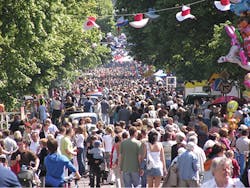DARPA asks for cooperating sensors technologies for data-rich urban monitoring
ARLINGTON, Va. — U.S. military researchers are approaching industry for new kinds of cooperating sensors to improve urban sensing capabilities for monitoring city traffic flow, crowd management, public safety monitoring, resource use, and environmental protection.
Cooperating and networked sensors could help researchers learn more about city traffic flow, crowd management, public safety monitoring, resource use, and environmental protection.
Officials of the U.S. Defense Advanced Research Projects Agency (DARPA) in Arlington, Va., issued a request for information (DARPA-SN-18-44) on new urban sensing technologies. Responses could support future DARPA programs to improve urban sensing capabilities.
From industry, DARPA researchers are interested in sensor capabilities, sensor packaging, unique and enabling sensor technologies, sensor technology maturity levels, concepts of operations, and system affordability for supporting urban sensing.
Of interest are low-cost, miniaturized sensors and sensor-packaging designs, with technology maturity levels that could support fielded experimentations within the next one to two years.
Sensor technologies should have extended operation durations, and involve visual, acoustic, optical, radio-frequency, pressure, spectrum, and polarization sensors to capture previously untapped properties and characteristics of urban elements, including crowd, pedestrians, objects, and activities.
The advancement of embedded technologies is driving rapid growth of sensing technologies that can yield data from citywide deployments for monitoring, modeling, and understanding urban activities, researchers explain.
DARPA would like responses from companies, universities, non-profit research centers, U.S. government laboratories, foreign entities, and individuals. Responses should involve technologies at least as mature as component and breadboard validation in the laboratory.
DARPA’s interests include:
- integrated multi-sensor suite technologies;
- composition of sensing elements and specifications;
- sensing operation specifications;
- system-level performance capabilities;
- capability to support cross-sensor elements data integration;
- data communication and networking capabilities;
- processor and storage capabilities;
- ways to reduce power consumption and enhance power harvesting;
- estimated size, weight, and power (SWaP) requirements;
- system affordability (cost) assessment;
- ability to integrate third-party sensing elements;
- technology maturity assessment;
- program outline for maturing the system for demonstration;
- sensing technologies;
- sensor specifications;
- sensing operation specifications;
- special or unique capabilities;
- ways to support cross-sensor, crosslocation data integration;
- data communication and networking capabilities;
- processor and storage capabilities;
- affordability assessment;
- technology maturity assessment;
- maturing subsystem technology for integration; and
- maturing the system for demonstration.
Companies interested should e-mail five-page responses to [email protected]. Email questions or concerns to the same address.
More information is online at https://www.fbo.gov/spg/ODA/DARPA/CMO/DARPA-SN-18-44/listing.html.

